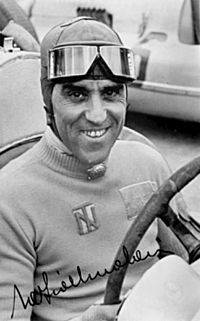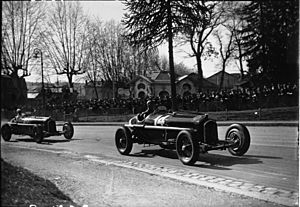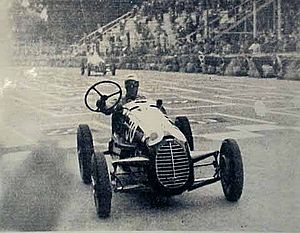Tazio Nuvolari facts for kids
Quick facts for kids
Tazio Nuvolari
|
|
|---|---|
 |
|
| Born |
Tazio Giorgio Nuvolari
16 November 1892 Castel d'Ario, Italy
|
| Died | 11 August 1953 (aged 60) Mantua, Italy
|
| Occupation | Racing driver |
| Spouse(s) |
Carolina Perina
(m. 1917–1953) |
| Children | Giorgio Nuvolari Alberto Nuvolari |
| Parent(s) | Arturo Nuvolari Elisa Zorzi |
Tazio Giorgio Nuvolari (born November 16, 1892 – died August 11, 1953) was an amazing Italian racing driver. People called him 'Il Mantovano Volante' (The Flying Mantuan) or just 'Nivola'. He started racing motorcycles, then became famous for driving sports cars and single-seater race cars.
Nuvolari won 72 major races and 150 races in total. These included 24 Grand Prix races, two Mille Miglias, two Targa Florios, and a 24 Hours of Le Mans race. He even won a European Championship in Grand Prix racing. Many people, like Ferdinand Porsche, thought he was the greatest driver ever.
Contents
Early Life and Family
Tazio Nuvolari was born in Castel d'Ario, near Mantua, Italy, on November 16, 1892. His father, Arturo, and uncle, Giuseppe, were both bicycle racers. Giuseppe was a national champion and a big inspiration to young Tazio.
Tazio married Carolina Perina. They had two sons, Giorgio and Alberto. Sadly, Giorgio passed away in 1937 at age 19 from a heart condition. Alberto died in 1946 at age 18 from kidney disease.
Becoming a Racing Star
Motorcycle Racing Beginnings
Nuvolari got his motorcycle racing license in 1915 when he was 23. During World War I, he worked as an ambulance driver for the Italian army. In 1920, he entered his first motorcycle race but didn't finish. He also raced cars early on, winning a reliability trial in 1921.
In 1925, he became the 350cc European Motorcycling champion. This was a very important title at the time. He won the Nations Grand Prix four times and the Lario Circuit race five times, all on a Bianchi motorcycle.
In 1925, Alfa Romeo wanted to test Nuvolari for their Grand Prix car. He crashed during the test and hurt his back. But just six days later, still injured and bandaged, he won a rainy race at Monza!
Switching to Car Racing
Driving for Alfa Romeo (1930-1932)
In 1930, Nuvolari decided to focus only on car racing. He won his first RAC Tourist Trophy that year. There's a funny story that during one race, he tried to grab a ham from a butcher's shop as he drove by!

Nuvolari and his co-driver Battista Guidotti won the Mille Miglia race in an Alfa Romeo 6C. They were the first to finish the race with an average speed over 100 kilometers per hour (62 mph). In a famous moment, Nuvolari followed his teammate Achille Varzi at night with his headlights off. He then turned them on to surprise and overtake Varzi right before the finish line!
In 1931, Nuvolari won the Coppa Ciano and the tough Targa Florio race. In 1932, he drove the fast Alfa Romeo P3 car. He won two European Championship Grand Prix races and finished second in another. This helped him win the European Championship title. He also won the famous Monaco Grand Prix and another Targa Florio. His mechanic once said that Nuvolari would shout during turns, telling him to duck down to lower the car's center of gravity!
A famous Italian writer, Gabriele d'Annunzio, gave Nuvolari a golden tortoise badge in 1932. Nuvolari wore it as a lucky charm, and it became a symbol connected to him.
Racing for Scuderia Ferrari and Maserati (1933-1937)
"Tazio Nuvolari was not simply a racing driver. To Italy he became an idol, a demi-god, a legend, epitomising all that young Italy aspired to be; the man who 'did the impossible', not once but habitually, the David who slew the Goliaths in the great sport of motor racing. He was Il Maestro."
In 1933, Alfa Romeo stopped racing officially, so Nuvolari drove for Enzo Ferrari's team, Scuderia Ferrari. He won the 1933 24 Hours of Le Mans race with his teammate Raymond Sommer. They had a big lead, but a fuel leak made them stop many times. Nuvolari kept driving, even breaking the lap record nine times, and they still won!
In 1934, Nuvolari broke his leg in a crash. But he was so determined that he raced just four weeks later! His car had to be changed so he could use his right foot for all the pedals. He still finished fifth, even with a broken leg.
The year 1935 brought Nuvolari's most famous win, called the 'Impossible Victory'. Driving an older Alfa Romeo P3 car at the German Grand Prix in Germany, he beat all the much more powerful German cars from Mercedes-Benz and Auto Union. This was a huge upset, and the crowd of 300,000 people cheered for him. It was the only time a non-German car won a European Championship race between 1935 and 1939.
By 1937, Nuvolari was getting frustrated with the quality of Alfa Romeo's cars. He even drove for Auto Union in one race.
Joining Auto Union (1938-1939)
In 1938, Nuvolari left Alfa Romeo and joined the Auto Union team. These cars were very fast and had a unique mid-engine design. With Auto Union, Nuvolari found more success. He won his home Grand Prix in Monza, Italy, and the Donington Grand Prix in England.
In 1939, he won the Belgrade Grand Prix. This was the last major race before World War II put a stop to Grand Prix racing.
Post-War Racing and Final Years
After the war, Nuvolari was 54 years old and not in good health. He still raced in 13 events in 1946, even winning the Grand Prix of Albi. People noticed he often steered with one hand, holding a handkerchief to his mouth with the other.
In 1948, despite his health problems and the loss of his two sons, Enzo Ferrari convinced him to race in the Mille Miglia. Nuvolari took a big lead but had to stop due to car problems.
His very last race was a hillclimb in Palermo on April 10, 1950. He won his class and finished fifth overall.
Nuvolari never officially retired from racing. His health got worse, and he became more private. In 1952, he had a stroke, which left him partly paralyzed. He passed away a year later from a second stroke.
Between 25,000 and 55,000 people, which was about half the population of Mantua, attended his funeral. His coffin was carried on a car chassis, pushed by other famous drivers like Alberto Ascari and Juan Manuel Fangio. He is buried in the family tomb in Mantua. The words on his tomb mean: 'You will race even faster along the roads of heaven'.
Legacy and Recognition
"…there will never be another Nuvolari and I shall always think of him as incomparable, the greatest of them all."
There is a museum dedicated to Tazio Nuvolari in his hometown of Mantua. In Castel d'Ario, there's a bronze statue of him. A square in Mantua where he lived is now called Piazza Nuvolari.
Several cars have been named after him, like the Cisitalia 202 SMM Nuvolari Spider and the Audi Nuvolari Quattro. Maserati even offers a special color called Grigio-Nuvolari.
Nuvolari was known for a special driving technique called the four-wheel drift, where he would slide the car through corners. Other famous drivers later used this technique.
His story has inspired songs, TV channels, and even a character reference in an episode of The Twilight Zone. A racing yacht built in 1978 was also named Nuvolari in his honor.
Images for kids
See also
 In Spanish: Tazio Nuvolari para niños
In Spanish: Tazio Nuvolari para niños






